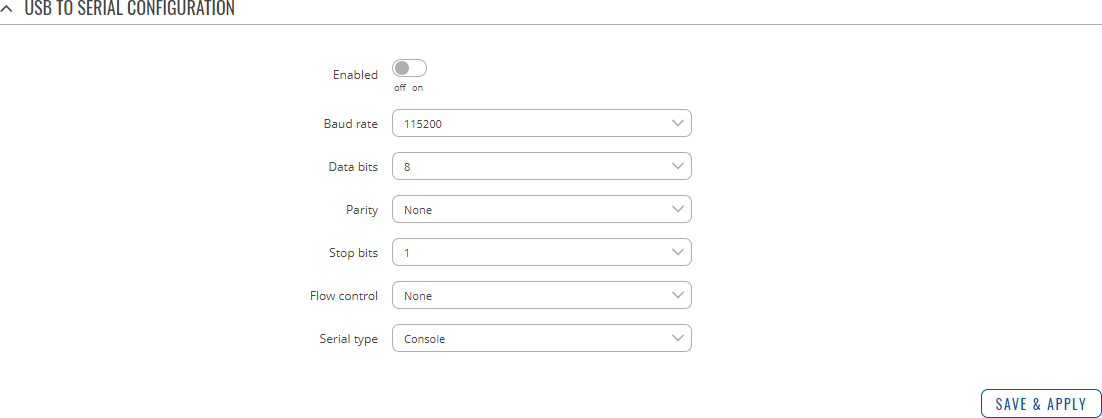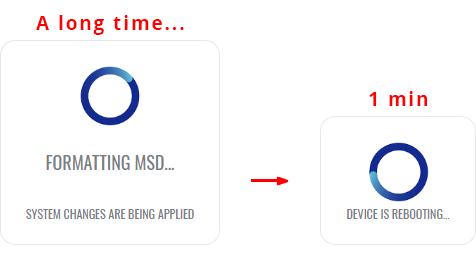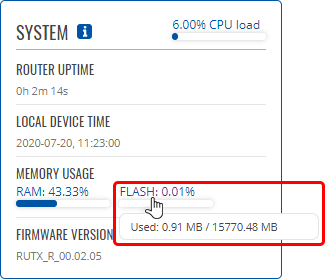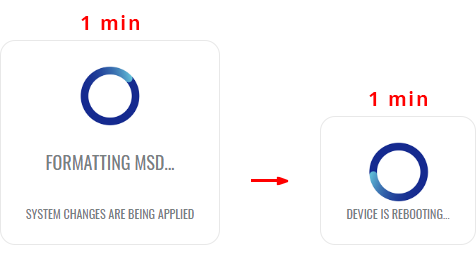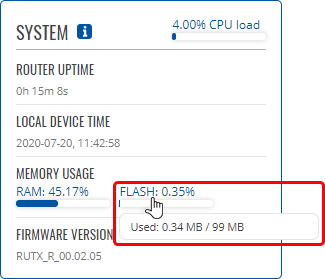Difference between revisions of "Template:Networking rutos manual usb tools"
| Line 69: | Line 69: | ||
The '<b>Refresh</b>' is used to refresh the information in the Mounted File Systems list. If you attach a new USB device and cannot see it in the list, try clicking the 'Refresh' button. | The '<b>Refresh</b>' is used to refresh the information in the Mounted File Systems list. If you attach a new USB device and cannot see it in the list, try clicking the 'Refresh' button. | ||
| + | {{#ifeq:{{{printer}}}|0|| | ||
==Printer Server== | ==Printer Server== | ||
| Line 85: | Line 86: | ||
<tr> | <tr> | ||
<td>Enable</td> | <td>Enable</td> | ||
| − | <td>off | + | <td>off {{!}} on; default: <b>off</b></td> |
<td>Turns USB printer support on or off.</td> | <td>Turns USB printer support on or off.</td> | ||
</tr> | </tr> | ||
| Line 100: | Line 101: | ||
<tr> | <tr> | ||
<td>Bidirectional mode</td> | <td>Bidirectional mode</td> | ||
| − | <td>off | + | <td>off {{!}} on; default: <b>on</b></td> |
<td>Turns bidirectional mode on or off.</td> | <td>Turns bidirectional mode on or off.</td> | ||
</tr> | </tr> | ||
| Line 106: | Line 107: | ||
For step-by-step instructions on how to use a printer with {{{name}}}, <b>[[How to set up a USB printer (Windows, {{{name}}})|click here]]</b> | For step-by-step instructions on how to use a printer with {{{name}}}, <b>[[How to set up a USB printer (Windows, {{{name}}})|click here]]</b> | ||
| − | + | }}{{#ifeq:{{{serial}}}|0|| | |
==USB to Serial== | ==USB to Serial== | ||
| Line 121: | Line 122: | ||
<tr> | <tr> | ||
<td>Enabled</td> | <td>Enabled</td> | ||
| − | <td>off | + | <td>off {{!}} on; default: <b>off</b></td> |
<td>Turns the USB to Serial service on or off.</td> | <td>Turns the USB to Serial service on or off.</td> | ||
</tr> | </tr> | ||
<tr> | <tr> | ||
<td>Baud rate</td> | <td>Baud rate</td> | ||
| − | <td>300 | + | <td>300 {{!}} 1200 {{!}} 2400 {{!}} 4800 {{!}} 9600 {{!}} 19200 {{!}} 38400 {{!}} 57600 {{!}} 115200; default: <b>115200</b></td> |
<td>Data rate for serial data transmission (in bits per second).</td> | <td>Data rate for serial data transmission (in bits per second).</td> | ||
</tr> | </tr> | ||
<tr> | <tr> | ||
<td>Data bits</td> | <td>Data bits</td> | ||
| − | <td>5 | + | <td>5 {{!}} 6 {{!}} 7 {{!}} 8; default: <b>8</b></td> |
<td>Number of data bits for each character</td> | <td>Number of data bits for each character</td> | ||
</tr> | </tr> | ||
<tr> | <tr> | ||
<td>Parity</td> | <td>Parity</td> | ||
| − | <td>None | + | <td>None {{!}} Odd {{!}} Even; default: <b>None</b></td> |
<td>In serial transmission, parity is a method of detecting errors. An extra data bit is sent with each data character, arranged so that the number of 1 bits in each character, including the parity bit, is always odd or always even. If a byte is received with the wrong number of 1s, then it must have been corrupted. However, an even number of errors can pass the parity check. | <td>In serial transmission, parity is a method of detecting errors. An extra data bit is sent with each data character, arranged so that the number of 1 bits in each character, including the parity bit, is always odd or always even. If a byte is received with the wrong number of 1s, then it must have been corrupted. However, an even number of errors can pass the parity check. | ||
<ul> | <ul> | ||
| Line 147: | Line 148: | ||
<tr> | <tr> | ||
<td>Stop bits</td> | <td>Stop bits</td> | ||
| − | <td>1 | + | <td>1 {{!}} 2; default: <b>1</b></td> |
<td>Stop bits sent at the end of every character allow the receiving signal hardware to detect the end of a character and to resynchronise with the character stream. Electronic devices usually use one stop bit. Two stop bits are required if slow electromechanical devices are used.</td> | <td>Stop bits sent at the end of every character allow the receiving signal hardware to detect the end of a character and to resynchronise with the character stream. Electronic devices usually use one stop bit. Two stop bits are required if slow electromechanical devices are used.</td> | ||
</tr> | </tr> | ||
<tr> | <tr> | ||
<td>Flow control</td> | <td>Flow control</td> | ||
| − | <td>None | + | <td>None {{!}} RTS/CTS {{!}} Xon/Xoff; default: <b>None</b></td> |
<td>In many circumstances a transmitter might be able to send data faster than the receiver is able to process it. To cope with this, serial lines often incorporate a "handshaking" method, usually distinguished between hardware and software handshaking. | <td>In many circumstances a transmitter might be able to send data faster than the receiver is able to process it. To cope with this, serial lines often incorporate a "handshaking" method, usually distinguished between hardware and software handshaking. | ||
<ul> | <ul> | ||
| Line 187: | Line 188: | ||
<tr> | <tr> | ||
<td>Protocol</td> | <td>Protocol</td> | ||
| − | <td>TCP | + | <td>TCP {{!}} UDP; default: <b>TCP</b></td> |
<td>Protocol used in the communication process.</td> | <td>Protocol used in the communication process.</td> | ||
</tr> | </tr> | ||
<tr> | <tr> | ||
<td>Mode</td> | <td>Mode</td> | ||
| − | <td><span style="color: purple;">Server</span> | + | <td><span style="color: purple;">Server</span> {{!}} <span style="color: red;">Client</span> {{!}} <span style="color: blue;">Bidirect</span>; default: <b>Server</b></td> |
<td>The role of this device in the serial connection: | <td>The role of this device in the serial connection: | ||
<ul> | <ul> | ||
| Line 203: | Line 204: | ||
<tr> | <tr> | ||
<td>No leading zeros</td> | <td>No leading zeros</td> | ||
| − | <td>off | + | <td>off {{!}} on; default: <b>off</b></td> |
<td>When checked, indicates that the first hex zeros should be skipped.</td> | <td>When checked, indicates that the first hex zeros should be skipped.</td> | ||
</tr> | </tr> | ||
| Line 218: | Line 219: | ||
<tr> | <tr> | ||
<td><span style="color: red;">Server settings</span>: Open port automatically</td> | <td><span style="color: red;">Server settings</span>: Open port automatically</td> | ||
| − | <td>off | + | <td>off {{!}} on; default: <b>on</b></td> |
<td>Automatically adds a traffic rule in the firewall configuration to open the required port for NTRIP communication.</td> | <td>Automatically adds a traffic rule in the firewall configuration to open the required port for NTRIP communication.</td> | ||
</tr> | </tr> | ||
<tr> | <tr> | ||
<td><span style="color: purple;">Client settings</span>: Server Address</td> | <td><span style="color: purple;">Client settings</span>: Server Address</td> | ||
| − | <td>ip | + | <td>ip {{!}} host; default: <b>none</b></td> |
<td>IP address or hostname of the server that this client will connect to.</td> | <td>IP address or hostname of the server that this client will connect to.</td> | ||
</tr> | </tr> | ||
| Line 238: | Line 239: | ||
<tr> | <tr> | ||
<td>Echo</td> | <td>Echo</td> | ||
| − | <td>off | + | <td>off {{!}} on; default: <b>off</b></td> |
<td>Turn USB to serial echo on or off.</td> | <td>Turn USB to serial echo on or off.</td> | ||
</tr> | </tr> | ||
| Line 267: | Line 268: | ||
<tr> | <tr> | ||
<td>Slave ID configuration type</td> | <td>Slave ID configuration type</td> | ||
| − | <td><span style="color: red;">User defined</span> | + | <td><span style="color: red;">User defined</span> {{!}} <span style="color: purple;">Obtained from TCP</span>;<br>default: <b><span style="color: red;">User defined</span></b></td> |
<td>Specifies whether slave IDs are user defined or automatically obtained from TCP.</td> | <td>Specifies whether slave IDs are user defined or automatically obtained from TCP.</td> | ||
</tr> | </tr> | ||
<tr> | <tr> | ||
| − | <td><span style="color: red;">Slave ID</span> | + | <td><span style="color: red;">Slave ID</span> {{!}} <span style="color: purple;">Permitted slave IDs</span></td> |
| − | <td><span style="color: red;">integer </span> | + | <td><span style="color: red;">integer </span> {{!}} <span style="color: purple;">range of integers</span>;<br>default: <b><span style="color: red;">1</span> or <span style="color: purple;">1-247</span></b></td> |
<td>Specifies the slave ID of range of permitted slave IDs. The way this field is named and its function depends on the value of the ''Slave ID configuration'' field. <br> A range of IDs can be specified by placing a hyphen (<i>-</i>) between two integer numbers. For example, if you permit slave IDs in the range of 10 to 20, you would specify it as: <i>10-20</i><br>You can also specify multiple values that are not connected in a range using commas (<i>,</i>). For example, to specify 6, 50 and 100 as permitted slave IDs, you would have to use: <i>6,50,100</i></td> | <td>Specifies the slave ID of range of permitted slave IDs. The way this field is named and its function depends on the value of the ''Slave ID configuration'' field. <br> A range of IDs can be specified by placing a hyphen (<i>-</i>) between two integer numbers. For example, if you permit slave IDs in the range of 10 to 20, you would specify it as: <i>10-20</i><br>You can also specify multiple values that are not connected in a range using commas (<i>,</i>). For example, to specify 6, 50 and 100 as permitted slave IDs, you would have to use: <i>6,50,100</i></td> | ||
</tr> | </tr> | ||
<tr> | <tr> | ||
<td>Open port automatically</td> | <td>Open port automatically</td> | ||
| − | <td>off | + | <td>off {{!}} on; default: <b>on</b></td> |
<td>Automatically adds a traffic rule in the firewall configuration to open the required port for serial communication.<br><b><u>Caution:</u></b> use with care if listening IP is left as the default value (<i>0.0.0.0</i>). Leaving it as such will leave the device open for remote connections on the specified port.</td> | <td>Automatically adds a traffic rule in the firewall configuration to open the required port for serial communication.<br><b><u>Caution:</u></b> use with care if listening IP is left as the default value (<i>0.0.0.0</i>). Leaving it as such will leave the device open for remote connections on the specified port.</td> | ||
</tr> | </tr> | ||
<tr> | <tr> | ||
<td>Echo</td> | <td>Echo</td> | ||
| − | <td>off | + | <td>off {{!}} on; default: <b>off</b></td> |
<td>Turn USB to serial echo on or off.</td> | <td>Turn USB to serial echo on or off.</td> | ||
</tr> | </tr> | ||
| Line 311: | Line 312: | ||
<tr> | <tr> | ||
<td>Mount point</td> | <td>Mount point</td> | ||
| − | <td>filepath | + | <td>filepath {{!}} string; default: <b>none</b></td> |
<td>NTRIP mount point.</td> | <td>NTRIP mount point.</td> | ||
</tr> | </tr> | ||
<tr> | <tr> | ||
<td>Data format</td> | <td>Data format</td> | ||
| − | <td>NTRIP V2.0 TCP/IP | + | <td>NTRIP V2.0 TCP/IP {{!}} NTRIP V2.0 RSTP/RTP {{!}} NTRIP V1.0 {{!}} Automatic detection {{!}} NTRIP V2.0 UDP; default: <b>NTRIP V1.0</b></td> |
<td>Version of NTRIP protocol.</td> | <td>Version of NTRIP protocol.</td> | ||
</tr> | </tr> | ||
| Line 336: | Line 337: | ||
<tr> | <tr> | ||
<td>Use device GPS</td> | <td>Use device GPS</td> | ||
| − | <td>off | + | <td>off {{!}} on; default: <b>off</b></td> |
<td>Allows to obtain default NMEA string from the router's GPS device. Only works if GPS service is enabled and location fix is obtained at the time of NTRIP service start.</td> | <td>Allows to obtain default NMEA string from the router's GPS device. Only works if GPS service is enabled and location fix is obtained at the time of NTRIP service start.</td> | ||
</tr> | </tr> | ||
<tr> | <tr> | ||
<td>Open port automatically</td> | <td>Open port automatically</td> | ||
| − | <td>off | + | <td>off {{!}} on; default: <b>on</b></td> |
<td>Automatically adds a traffic rule in the firewall configuration to open the required port for serial communication.</td> | <td>Automatically adds a traffic rule in the firewall configuration to open the required port for serial communication.</td> | ||
</tr> | </tr> | ||
<tr> | <tr> | ||
<td>Echo</td> | <td>Echo</td> | ||
| − | <td>off | + | <td>off {{!}} on; default: <b>off</b></td> |
<td>Turn USB to serial echo on or off.</td> | <td>Turn USB to serial echo on or off.</td> | ||
</tr> | </tr> | ||
</table> | </table> | ||
| − | + | }} | |
==Storage Memory Expansion== | ==Storage Memory Expansion== | ||
| Line 400: | Line 401: | ||
<li>Your device's flash memory will be restored to normal once the reboot has finished. In order to check, log in to the WebUI and look to the 'System' widget in the 'Overview' page. Hover your mouse cursor over the 'FLASH' memory indicator; you should see your device's flash memory return to its regular size.<br>[[File:Networking_rutos_manual_storage_memory_expansion_disable_4.png|border|class=tlt-border]]</li> | <li>Your device's flash memory will be restored to normal once the reboot has finished. In order to check, log in to the WebUI and look to the 'System' widget in the 'Overview' page. Hover your mouse cursor over the 'FLASH' memory indicator; you should see your device's flash memory return to its regular size.<br>[[File:Networking_rutos_manual_storage_memory_expansion_disable_4.png|border|class=tlt-border]]</li> | ||
</ol> | </ol> | ||
| − | + | {{#ifeq:{{{shares}}}|0|| | |
==Network Shares== | ==Network Shares== | ||
| Line 425: | Line 426: | ||
<tr> | <tr> | ||
<td>Enable</td> | <td>Enable</td> | ||
| − | <td>off | + | <td>off {{!}} on; default: <b>off</b></td> |
<td>Turns Samba on or off.</td> | <td>Turns Samba on or off.</td> | ||
</tr> | </tr> | ||
| Line 445: | Line 446: | ||
<tr> | <tr> | ||
<td>Share home-directories</td> | <td>Share home-directories</td> | ||
| − | <td>off | + | <td>off {{!}} on; default: <b>on</b></td> |
<td>Allows system users to reach their home directories via network shares.</td> | <td>Allows system users to reach their home directories via network shares.</td> | ||
</tr> | </tr> | ||
| Line 452: | Line 453: | ||
===Edit Template=== | ===Edit Template=== | ||
---- | ---- | ||
| − | The <b>Edit Template</b> section is used to make modifications to the template that is used for generating the Samba configuration. This is the content of the <i>/etc/samba/smb.conf.template</i> file from which your Samba configuration will be generated. Values enclosed by pipe symbols (' | + | The <b>Edit Template</b> section is used to make modifications to the template that is used for generating the Samba configuration. This is the content of the <i>/etc/samba/smb.conf.template</i> file from which your Samba configuration will be generated. Values enclosed by pipe symbols ('{{!}}') should not be changed. They get their values from the 'General Settings' tab. |
[[File:Networking_rutos_manual_usb_tools_network_shares_general_samba_edit_template.png|border|class=tlt-border]] | [[File:Networking_rutos_manual_usb_tools_network_shares_general_samba_edit_template.png|border|class=tlt-border]] | ||
| Line 495: | Line 496: | ||
<tr> | <tr> | ||
<td>Read-only</td> | <td>Read-only</td> | ||
| − | <td>off | + | <td>off {{!}} on; default: <b>off</b></td> |
<td>Makes a Shared Directory read-only, which means the directory can only be accessed to view and read files (not write).</td> | <td>Makes a Shared Directory read-only, which means the directory can only be accessed to view and read files (not write).</td> | ||
</tr> | </tr> | ||
<tr> | <tr> | ||
<td>Browseable</td> | <td>Browseable</td> | ||
| − | <td>off | + | <td>off {{!}} on; default: <b>on</b></td> |
<td>Makes a Shared Directory browsable; i.e., visible in shared directory network discovery.</td> | <td>Makes a Shared Directory browsable; i.e., visible in shared directory network discovery.</td> | ||
</tr> | </tr> | ||
<tr> | <tr> | ||
<td>Allow guests</td> | <td>Allow guests</td> | ||
| − | <td>off | + | <td>off {{!}} on; default: <b>off</b></td> |
<td>Turns guest access on or off. Guest access allows anonymous connections to a Shared Directory.</td> | <td>Turns guest access on or off. Guest access allows anonymous connections to a Shared Directory.</td> | ||
</tr> | </tr> | ||
| Line 539: | Line 540: | ||
[[File:Networking_rutos_manual_usb_tools_network_shares_users_user_settings.png|border|class=tlt-border]] | [[File:Networking_rutos_manual_usb_tools_network_shares_users_user_settings.png|border|class=tlt-border]] | ||
| − | + | }} | |
[[Category:{{{name}}} Services section]] | [[Category:{{{name}}} Services section]] | ||
Revision as of 14:10, 5 March 2021
Template:Networking rutos manual fw disclosure
Summary
The USB Tools page is used to manage services related to the device's USB connector.
This chapter of the user manual provides an overview of the USB Tools page in {{{name}}} devices.
If you're having trouble finding this page or some of the parameters described here on your device's WebUI, you should turn on "Advanced WebUI" mode. You can do that by clicking the "Advanced" button, located at the top of the WebUI.
General
The General section is used to manage global USB settings. It consists of two subsections:
USB Mount Settings
The USB Mount Settings section is used to set the transfer type (synchronous or asynchronous) for the USB device.
Synchronous ensures that all changes to the according filesystem are immediately flushed to disk. Enabling this will drastically lower the life expectancy of your USB device.
Mounted File Systems
The Mounted File Systems list displays USB mass storage devices (MSD) currently attached to this device.
| Field | Value | Description |
|---|---|---|
| Filesystem | filepath; default: /dev/sd* | The filesystem of the attached USB MSD. |
| Mount Point | filepath; default: /mnt/sd* | The root directory of the mounted filesystem. |
| Available | string; default: none | Displays available storage information for a mounted USB MSD. |
| Used | string; default: none | Displays used storage information for a mounted USB MSD. |
| In Use | string; default: none | Indicates whether a USB MSD is currently in use by some device service or not. |
The 'Unmount' button next to each entry in the list is used to unmount an attached USB device. Please make sure to unmount a USB device before physically detaching it from the {{{name}}}.
The 'Refresh' is used to refresh the information in the Mounted File Systems list. If you attach a new USB device and cannot see it in the list, try clicking the 'Refresh' button.
Printer Server
The Printer Server feature provides the possibility to configure access to a printer that is connected to the USB port of the device. After the printer is connected to the device's USB port and configured, it can be utilized by users in the local network (LAN, WiFi) or remotely.
The 'Add' button lets you add and manage additional printers. To configure a printer instance, click the Edit button located next to it:
| Field | Value | Description |
|---|---|---|
| Enable | off | on; default: off | Turns USB printer support on or off. |
| Device | filepath; default: /dev/usb/lp0 | Printer's device file. |
| Port | integer [9100..9109]; default: 9100 | Printer's TCP port. |
| Bidirectional mode | off | on; default: on | Turns bidirectional mode on or off. |
For step-by-step instructions on how to use a printer with {{{name}}}, [[How to set up a USB printer (Windows, {{{name}}})|click here]]==USB to Serial==
The device's USB connector can also be used as a serial port.
| Field | Value | Description | |||||||||||||||||||||||||||||||||||||||||
|---|---|---|---|---|---|---|---|---|---|---|---|---|---|---|---|---|---|---|---|---|---|---|---|---|---|---|---|---|---|---|---|---|---|---|---|---|---|---|---|---|---|---|---|
| Enabled | off | on; default: off | Turns the USB to Serial service on or off. | |||||||||||||||||||||||||||||||||||||||||
| Baud rate | 300 | 1200 | 2400 | 4800 | 9600 | 19200 | 38400 | 57600 | 115200; default: 115200 | Data rate for serial data transmission (in bits per second). | |||||||||||||||||||||||||||||||||||||||||
| Data bits | 5 | 6 | 7 | 8; default: 8 | Number of data bits for each character | |||||||||||||||||||||||||||||||||||||||||
| Parity | None | Odd | Even; default: None | In serial transmission, parity is a method of detecting errors. An extra data bit is sent with each data character, arranged so that the number of 1 bits in each character, including the parity bit, is always odd or always even. If a byte is received with the wrong number of 1s, then it must have been corrupted. However, an even number of errors can pass the parity check.
|
|||||||||||||||||||||||||||||||||||||||||
| Stop bits | 1 | 2; default: 1 | Stop bits sent at the end of every character allow the receiving signal hardware to detect the end of a character and to resynchronise with the character stream. Electronic devices usually use one stop bit. Two stop bits are required if slow electromechanical devices are used. | |||||||||||||||||||||||||||||||||||||||||
| Flow control | None | RTS/CTS | Xon/Xoff; default: None | In many circumstances a transmitter might be able to send data faster than the receiver is able to process it. To cope with this, serial lines often incorporate a "handshaking" method, usually distinguished between hardware and software handshaking.
|
|||||||||||||||||||||||||||||||||||||||||
| Serial type | Console
Storage Memory ExpansionThe Storage Memory Expansion function provides the possibility to expand the device's flash memory with a USB Mass Storage Device (MSD) and use the extra memory to install additional software packages. This section provides instruction on how to do just that. However, there are a few prerequisites and warnings to take note of before using memory expansion. To be eligible for memory expansion, the USB MSD must meet the following restrictions.
When expansion is enabled, do not detach the USB device as this will delete the data stored on it. Changes made to the device configuration while expansion was enabled will disappear after it is disabled. Enabling memory expansionTo successfully expand the flash memory of your device follow the steps described below.
Disabling memory expansionTo successfully disable memory expansion follow the steps described below.
The Network Shares section is used to manage Network-attached storage (NAS) such as USB drives and hard drives. The {{{name}}} device supports the following file system architectures:
General SettingsThe General section is used to set up Samba - a software solution for using the Server Message Block (SMB) networking protocol, which provides shared file access between nodes on a computer network. Refer to the figures and table below for more information about Samba configuration.
Edit TemplateThe Edit Template section is used to make modifications to the template that is used for generating the Samba configuration. This is the content of the /etc/samba/smb.conf.template file from which your Samba configuration will be generated. Values enclosed by pipe symbols ('|') should not be changed. They get their values from the 'General Settings' tab. Format USBThe Format USB section contains only one button that is used for formatting an attached USB drive. The Shared Directories section is used to configure access to the device's files and directories, including USB storage drives. The list of Shared Directories is empty by default; click the 'Add' button in order to create a new configuration: The newly added Shared Directory configuration should look similar to this:
To connect to the router's SAMBA server from Windows, specify the address in this format: \\smb_server_address\share_name Replace smb_server_address with the IP address of this device or SAMBA share hostname; replace share_name with the name of the "share" (as specified in the 'Name' field). For example:
\\192.168.1.1\my_share \\Router_share\johns_files
UsersThe Users section is used to create Samba users that can be granted access to Shared Directories. To add a new user, enter a custom username, password and click the 'Add' button. The newly added User should appear in the Users list. To change the password of a Samba User, click the 'Edit' button located next to it: This will redirect you to the Settings page for that User which should look similar to this: |




